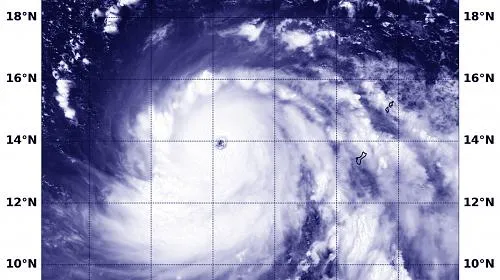MANILA (September 12, 2018) – Typhoon Mangkhut (locally known as Ompong), the strongest typhoon to hit the Philippines this year, continues to intensify. The Hawaii-based Joint Typhoon Warning Center (JTWC) has classified Mangkhut into a super typhoon. It is currently equivalent to a category 5 Atlantic hurricane, with winds of at least 157 miles per hour.
Today, as of 11 am (Philippine time), Mangkhut was already 740 miles northeast of Guiuan in the eastern tip of the country’s Samar island, moving west steadily. The typhoon is expected to hit the northern part of Luzon, the country’s largest, most populated island, and may cross the island province of Batanes and Cagayan areas towards the end of the week.
“This is very unfortunate for the people of northern Luzon who experienced the wrath of relatively strong typhoons since 2016,” says David Gazashvili, CARE’s country director in the Philippines. “Our teams will be ready to conduct rapid assessments once the typhoon hits. We are prepared to respond if needed.” Local authorities warn people to prepare for storm surges in coastal communities, and landslides and flashfloods in upland and low-lying areas. Its powerful winds can uproot trees and topple electric posts.
CARE is closely monitoring the track of Mangkhut, and coordinating with its partner Cagayan Valley Disaster Response Center & Cordillera Disaster Response and Development Services. CARE previously responded to Typhoon Haima (Lawin) that devastated Cagayan and Kalinga provinces in October 2016.
CARE has worked in the Philippines since 1949, providing emergency relief when disaster strikes and helping communities prepare for disasters. CARE’s past responses in the Philippines have included typhoon Haiyan in 2013, Hagupit in 2014, Koppu and Melor in 2015, and Haima in 2016.
About CARE:
Founded in 1945, CARE is a leading humanitarian organization fighting global poverty. CARE has more than seven decades of experience helping people prepare for disasters, providing lifesaving assistance when a crisis hits, and helping communities recover after the emergency has passed. CARE places special focus on women and children who are often disproportionately affected by disasters. Last year, CARE worked in 94 countries to reach 80 million people, including more than 11 million through emergency response and humanitarian aid.
CARE has been providing aid in Syria since 2014, and has reached more than 3 million people to date. Our work is focused on food security, livelihoods, shelter, water and sanitation, and psychosocial support for people in crisis. CARE also works in Jordan, Lebanon and Turkey with Syrian refugees and host communities.
To learn more, visit www.care.org.
Media Contacts:
Mahmoud Shabeeb, +962-79-146-39-03 mshabeeb@care.org (based in Amman, Jordan)
Nicole Harris, 404-735-0871 nharris@care.org

